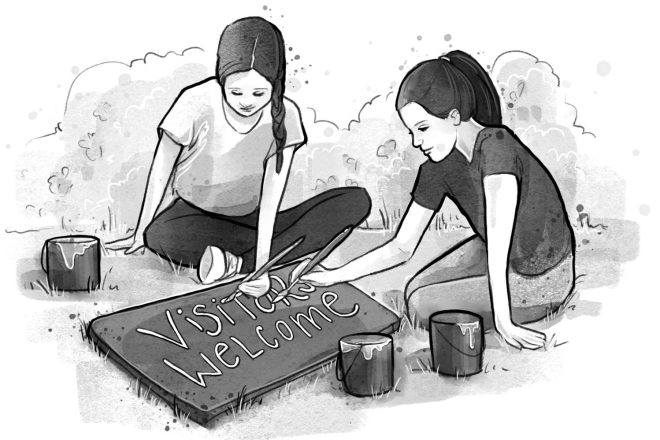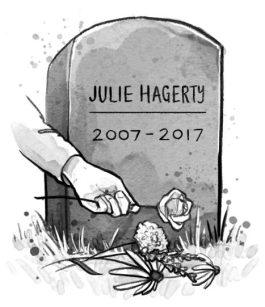I recruited my granddaughters to paint the sign. Sofi, the 10-year-old, was enthusiastic and started right away to take the paints from the cabinet. Bella, the 12-year-old, was skeptical.
“Why would you want to do that?” she asked.
I tried to explain to her that inviting passersby to visit my flower garden was a way of sharing. I said something about trusting people and the right-to-roam ethos in Britain, but I lost her there.
“Would you want strangers roaming through your house?” she asked.
I said the garden was different.
“How?” Bella said.
I said there was nothing to steal.
“What about the flowers?”
I gave up and suggested that she could do something else. But, in the end, she pitched in. The two of them produced a colorful sign on a board that said Visitors Welcome.
I attached the sign to the garden gate. The gate faced the drive that connected the road above my house to the one below. It was a shortcut for kids going to the high school and was occasionally used by other walkers.
It is, if I may say, a lovely garden. I favor native plants to attract local birds, bees, and butterflies, with several plants having “weed” in their names like milkweed, Joe Pye weed, and ironweed. I’d built stone paths that wound through the garden and placed a wooden bench at one end. I was especially fond of my blue rose, since it was delicate and needed more coaxing to bloom.
I try to spend some one-on-one time with each of my granddaughters, so the following Friday, I invited Sofi to stay overnight. I took her on my usual morning walk on Saturday, part of which was through a cemetery.
“Why do you like to walk through a creepy cemetery, Papa?” she asked. (My granddaughters ask lots of questions.)

I said that I found it comforting. I read the gravestones close to the road and imagine the lives attached to the names. I make a point of stopping at a grave that is in the newer section. The name on the stone is Julie Hagerty. She died six years ago at age 10, the same age as Sofi. The very next day would have been her 16th birthday.
“What happened to her?” Sofi asked.
I said that I didn’t know—maybe she got sick or had an accident. We walked back home and fixed lunch. As we sat at the kitchen counter looking at my garden, I noticed that the gate was open and a man, who appeared to be in his 40’s, was sitting on the bench.
“Do you know him, Papa?”
“No, I don’t think so.”
I had not considered this situation—if I had visitors, should I ignore them? Wave from the kitchen window? Walk outside and say hello? I decide to stay put and see what would happen.
After a few minutes, the man stood and began to walk along the paths. He pulled something out—a pocket knife! He began cutting flowers—zinnias, cone flowers, lavender, even one of my blue roses.
“What the … ?” I said as I stood up.
“He’s taking your flowers!” said Sofi. I was too distracted to do anything but watch. The man was in no hurry—he didn’t look back over his shoulder or scurry around like a thief. In fact, he sat down on the bench with his bouquet.
“Aren’t you going to go out and say something to him?” Sofi asked. I said that I didn’t want to create a conflict over a few flowers, especially since the man didn’t seem to have malicious intent.
On the other hand, I felt that I had to acknowledge the moral lesson that stealing from others is bad. I began to head outside to make myself visible to this stranger. Just as I reached the door, however, he stood, went out the gate, and walked slowly up the drive.

I looked at the sign as I closed the garden gate and wondered if I should take it down. What other unusual visits could it encourage? Teenagers drinking beer or smoking joints on my bench?
My son picked up his daughter later that afternoon.
“Someone stole Papa’s flowers,” I heard her say to her father as she got into the car.
The next day, I did my usual late morning walk through the neighborhood above my house. In the cemetery, as I approached Julie’s grave, I saw that flowers had been placed at the foot of her headstone. I noticed lavender, zinnias, and coneflowers. On the bottom of the pile was a slightly wilted blue rose.
I bent over and gently turned over the bouquet so that the blue rose was on top. ❖
This article was published originally in 2023, in GreenPrints Issue #134.



